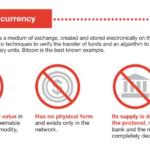The Ethics of Crypto Investments: Navigating the rapidly evolving world of cryptocurrency requires careful consideration of ethical implications. From the environmental impact of mining to the potential for market manipulation and the risks faced by inexperienced investors, the ethical landscape of this burgeoning industry is complex and multifaceted. This exploration delves into the key ethical dilemmas surrounding crypto investments, examining both the opportunities and the challenges.
We will investigate the environmental cost of cryptocurrency mining, analyze the volatility inherent in the market, and explore the crucial role of transparency and regulation. Furthermore, we will consider the influence of social media, the accessibility of crypto investments for diverse populations, and the critical need for security and responsible financial practices within this dynamic sector.
Environmental Impact of Cryptocurrency Mining
The environmental impact of cryptocurrency mining, particularly Bitcoin, is a significant concern. The process of verifying and adding transactions to the blockchain requires substantial computational power, leading to high energy consumption and greenhouse gas emissions. This energy consumption varies depending on the specific cryptocurrency and the mining methods employed. Understanding this impact is crucial for evaluating the long-term sustainability of the cryptocurrency industry.
Energy Consumption of Different Crypto Mining Methods
Different cryptocurrencies utilize varying consensus mechanisms and algorithms, resulting in different energy consumption profiles. Proof-of-work (PoW) systems, like Bitcoin, require miners to solve complex computational problems to validate transactions. This process is energy-intensive, consuming vast amounts of electricity. In contrast, proof-of-stake (PoS) systems, employed by cryptocurrencies such as Ethereum 2.0, require validators to stake their coins, reducing energy consumption significantly. The energy efficiency of mining hardware also plays a crucial role; newer, more efficient Application-Specific Integrated Circuits (ASICs) consume less energy than older generations. The geographic location of mining operations also matters, with some regions relying on renewable energy sources, while others depend on fossil fuels. Ultimately, the total energy consumption is a complex interplay of these factors.
Carbon Footprint of Bitcoin Mining Compared to Traditional Financial Systems
Direct comparisons of Bitcoin’s carbon footprint to that of traditional financial systems are challenging due to the complexities of data collection and the varying methodologies used. However, studies have attempted to quantify these impacts. Some research suggests that Bitcoin’s energy consumption and resulting carbon emissions are comparable to, or even exceed, those of smaller countries. This is primarily due to the massive computational power required for its PoW consensus mechanism. On the other hand, traditional financial systems have their own significant environmental footprints, associated with building and maintaining physical infrastructure, data centers, and transportation. While the carbon footprint of traditional finance is spread across various activities, Bitcoin’s impact is concentrated in the mining process. A comprehensive comparison requires a nuanced approach, considering the entire lifecycle of both systems and employing consistent measurement methodologies.
Potential Solutions for Reducing the Environmental Impact of Cryptocurrency Mining
Several strategies can mitigate the environmental impact of cryptocurrency mining. The transition to more energy-efficient consensus mechanisms, such as proof-of-stake, is a key step. This reduces the computational demands and, consequently, the energy consumption. Increased adoption of renewable energy sources for powering mining operations is also crucial. Mining farms located near hydroelectric or geothermal power plants can significantly reduce their carbon footprint. Technological advancements in mining hardware continue to improve energy efficiency, leading to lower energy consumption per transaction. Furthermore, regulatory frameworks could incentivize the use of renewable energy and discourage mining operations relying on fossil fuels. Finally, greater transparency and standardization in reporting energy consumption and carbon emissions across the cryptocurrency industry are essential for informed decision-making and effective environmental stewardship.
Volatility and Risk Management in Crypto Investments
The cryptocurrency market is renowned for its extreme price fluctuations, presenting both significant opportunities and substantial risks for investors. Understanding the factors driving this volatility and implementing effective risk management strategies are crucial for navigating this dynamic landscape ethically and responsibly. This section will explore the key drivers of volatility and Artikel practical approaches to mitigating risk, while also considering the ethical implications of promoting high-risk investments to those lacking sufficient experience.
Several factors contribute to the inherent volatility of cryptocurrency prices. Firstly, the relatively young age and small market capitalization of many cryptocurrencies compared to traditional assets mean they are susceptible to larger price swings based on relatively small trading volumes. Secondly, the decentralized nature of cryptocurrencies, while a key strength, also means they are less regulated and therefore more prone to speculation and manipulation. News events, regulatory announcements, technological developments, and even social media trends can significantly impact market sentiment and drive dramatic price changes. Finally, the lack of intrinsic value for many cryptocurrencies, unlike stocks or bonds which represent ownership in a company or a debt instrument, means their value is entirely determined by supply and demand, making them vulnerable to speculative bubbles and rapid price corrections.
Factors Contributing to Cryptocurrency Volatility
The unpredictable nature of cryptocurrency prices stems from a complex interplay of factors. Market sentiment, driven by news, social media trends, and overall economic conditions, plays a significant role. For example, positive news about a specific cryptocurrency or the broader crypto market can lead to a rapid price surge, while negative news or regulatory uncertainty can trigger a sharp decline. Technological advancements, such as the launch of new cryptocurrencies or upgrades to existing blockchain networks, also influence prices. Furthermore, the limited supply of many cryptocurrencies, combined with increasing demand, can create upward pressure on prices. Conversely, increased supply or decreased demand can lead to significant price drops. Finally, the actions of large investors or “whales” can significantly impact market dynamics, leading to substantial price volatility.
Effective Risk Management Strategies for Crypto Investors
Given the inherent volatility of the cryptocurrency market, implementing a robust risk management strategy is paramount. This involves a multifaceted approach that considers both individual circumstances and market dynamics. Diversification across different cryptocurrencies and asset classes is a fundamental principle. This reduces the impact of losses should one particular cryptocurrency underperform. Dollar-cost averaging (DCA), a strategy of investing a fixed amount of money at regular intervals regardless of price, helps mitigate the risk of investing a lump sum at a market peak. Setting stop-loss orders, which automatically sell a cryptocurrency when it reaches a predetermined price, limits potential losses. Finally, thorough research and due diligence are essential before investing in any cryptocurrency, including understanding the project’s fundamentals, team, and technology.
Ethical Implications of Promoting High-Risk Crypto Investments to Inexperienced Individuals, The Ethics of Crypto Investments
Promoting high-risk crypto investments to individuals lacking sufficient knowledge or understanding of the market raises significant ethical concerns. Such promotion can lead to substantial financial losses for inexperienced investors who may not fully grasp the inherent risks involved. Ethical considerations necessitate transparency and responsible disclosure of risks, ensuring that potential investors are fully informed before making any investment decisions. This includes clearly communicating the potential for significant losses and the lack of regulatory protection in the cryptocurrency market. Furthermore, marketing materials should avoid misleading or exaggerated claims about potential returns, and financial advisors should prioritize client interests over personal gain when recommending crypto investments. Failure to adhere to these ethical principles can lead to significant harm and erode trust in the cryptocurrency market as a whole. The 2021 collapse of several memecoins, for example, highlighted the dangers of speculative investments driven by hype and a lack of due diligence.
Transparency and Decentralization in Crypto Markets
Cryptocurrencies are often touted for their decentralized nature and the potential for increased transparency in financial transactions. However, the reality is more nuanced, with both significant advantages and persistent challenges. Understanding the interplay between decentralization and transparency is crucial for navigating the complexities of the crypto market.
Decentralization in the context of cryptocurrency refers to the distribution of power and control away from a central authority, such as a government or bank. Instead of relying on a single entity to validate and process transactions, cryptocurrencies utilize distributed ledger technology (DLT), most notably blockchain, where transactions are recorded across a network of computers. This distributed nature makes the system theoretically more resistant to censorship and single points of failure. Each transaction is cryptographically secured and verified by multiple nodes, enhancing security and reducing the risk of manipulation. Bitcoin, for example, is a prime illustration of a decentralized cryptocurrency, with no single entity controlling its network.
Challenges to Transparency in Cryptocurrency Markets
Despite the inherent potential for transparency, several factors can hinder it in cryptocurrency markets. The pseudonymous nature of many transactions, while protecting user privacy, can also obscure the identities of actors involved in illicit activities, making it difficult to track money laundering or other illegal operations. Furthermore, the complexity of blockchain technology itself can be a barrier to understanding transaction details for non-technical users. The lack of standardized reporting and regulatory frameworks across different jurisdictions further complicates efforts to ensure transparency. The existence of opaque decentralized exchanges (DEXs) and the use of privacy coins like Monero also contribute to reduced transparency. The sheer volume of transactions on some blockchains can make thorough analysis and auditing challenging, potentially masking suspicious activity.
Methods for Evaluating Transparency and Security of Crypto Projects
Evaluating the transparency and security of different crypto projects requires a multi-faceted approach. Firstly, examining the project’s whitepaper is crucial. A well-written whitepaper will clearly Artikel the project’s goals, technology, and security measures. Secondly, analyzing the project’s code on platforms like GitHub can reveal potential vulnerabilities or security flaws. Thirdly, assessing the level of community engagement and the project’s track record can provide insights into its reliability and trustworthiness. A project with a large, active community and a history of delivering on its promises is generally considered more secure and transparent. Fourthly, scrutinizing the project’s auditing history is vital. Independent audits by reputable firms can offer assurance about the security of the smart contracts and the overall system. Finally, looking at the project’s tokenomics and governance model helps to understand the distribution of power and potential for manipulation. Projects with a transparent and decentralized governance structure are typically more resilient and less susceptible to manipulation. For example, a project with a clearly defined token allocation and a transparent process for decision-making is generally viewed as more trustworthy than one with opaque governance.
Regulatory Frameworks and Ethical Considerations
The rapid growth of cryptocurrencies has outpaced the development of comprehensive regulatory frameworks globally, creating a complex landscape of varying approaches and significant ethical challenges. This section examines the diverse regulatory responses to cryptocurrencies across different jurisdictions and analyzes the ethical dilemmas arising from this regulatory ambiguity. A hypothetical framework aiming for a balance between fostering innovation and protecting consumers will also be proposed.
The lack of a universally accepted regulatory framework for cryptocurrencies presents numerous ethical dilemmas. These stem from the inherent characteristics of crypto, such as decentralization, anonymity, and volatility. The absence of clear rules creates opportunities for illicit activities, market manipulation, and investor exploitation, demanding careful consideration of ethical principles in the design of any regulatory approach.
Comparative Analysis of Crypto Regulatory Approaches
Different countries have adopted vastly different approaches to regulating cryptocurrencies, ranging from outright bans to relatively permissive frameworks. China, for instance, has implemented a strict ban on cryptocurrency trading and mining, citing concerns about financial stability and illicit activities. In contrast, El Salvador has embraced Bitcoin as legal tender, demonstrating a radically different approach. The European Union is currently developing a comprehensive regulatory framework for crypto assets (MiCA), aiming to balance innovation with consumer and investor protection. The United States, on the other hand, has a fragmented regulatory landscape, with different agencies overseeing various aspects of the cryptocurrency market, leading to inconsistencies and uncertainty. These diverse approaches highlight the global challenge of creating a cohesive and effective regulatory environment for cryptocurrencies.
Ethical Dilemmas Posed by Regulatory Gaps
The absence of clear and consistent regulatory frameworks for cryptocurrencies creates several significant ethical dilemmas. One key concern is the potential for fraud and scams. The lack of robust oversight allows fraudulent projects to flourish, exploiting unsuspecting investors. Another ethical challenge relates to money laundering and terrorist financing. The pseudonymous nature of many cryptocurrencies makes them attractive tools for illicit activities, requiring effective regulatory mechanisms to prevent their misuse. Furthermore, the extreme volatility of the cryptocurrency market poses significant risks to investors, particularly those lacking sufficient financial literacy. The absence of adequate consumer protection measures exacerbates these risks, raising ethical questions about the responsibility of governments and regulatory bodies.
A Hypothetical Regulatory Framework for Cryptocurrencies
A balanced regulatory framework for cryptocurrencies should prioritize both fostering innovation and protecting consumers. This hypothetical framework would incorporate several key elements. First, a clear definition of crypto assets and their classification would be crucial to establishing a consistent legal basis. Second, robust anti-money laundering (AML) and know-your-customer (KYC) regulations would be essential to mitigate the risks of illicit activities. Third, consumer protection measures, including investor education initiatives and clear disclosure requirements for crypto projects, would be necessary to safeguard investors. Fourth, a regulatory sandbox approach would allow for the testing and development of innovative crypto projects in a controlled environment, promoting responsible innovation while mitigating risks. Finally, international cooperation would be vital to address the cross-border nature of cryptocurrencies and prevent regulatory arbitrage. This framework aims to create a regulatory environment that supports responsible innovation in the cryptocurrency sector while safeguarding investors and maintaining financial stability.
The Role of Influencers and Marketing in Crypto
The cryptocurrency market, characterized by its volatility and complexity, is significantly influenced by marketing strategies and the endorsements of prominent figures. Social media personalities, often with large and engaged followings, wield considerable power in shaping public perception and driving investment decisions. This influence, while potentially beneficial in raising awareness, also presents significant ethical challenges that require careful consideration.
The rapid growth of the crypto space has seen a parallel rise in influencer marketing. Many celebrities and online personalities promote various cryptocurrencies, often receiving substantial compensation for their endorsements. This creates a complex interplay between financial incentives and the responsibility to provide accurate and unbiased information to their audiences. The lack of robust regulatory oversight in many jurisdictions exacerbates the potential for manipulation and misinformation.
Influence of Social Media Personalities on Crypto Investment Decisions
Social media influencers, particularly on platforms like YouTube, Twitter, and Instagram, can significantly impact individual investment choices. Their endorsements, often presented as expert advice, can sway followers, particularly those with limited financial literacy, to invest in specific cryptocurrencies regardless of their inherent risks. This influence is amplified by the often-enthusiastic and positive portrayal of cryptocurrencies, which can overshadow potential downsides and risks. For example, a well-known YouTuber promoting a relatively unknown cryptocurrency could trigger a rapid surge in its price, followed by a potential crash as investors realize the lack of fundamental value. This highlights the need for critical evaluation of information received from influencers.
Ethical Concerns Related to Misleading or Manipulative Marketing Tactics
The crypto space has witnessed numerous instances of misleading and manipulative marketing tactics. These include pump-and-dump schemes, where influencers artificially inflate the price of a cryptocurrency before selling their holdings, leaving their followers with substantial losses. Another concern is the lack of transparency regarding affiliations and financial incentives. Influencers often fail to disclose their relationships with cryptocurrency projects, creating a conflict of interest and potentially misleading their audience. The use of fake testimonials and exaggerated claims about potential returns further exacerbates the ethical issues. The inherent anonymity and decentralized nature of some cryptocurrencies also facilitate fraudulent activities and make it difficult to track and prosecute perpetrators.
Guidelines for Ethical Marketing and Promotion of Cryptocurrencies
Establishing clear guidelines for ethical marketing and promotion is crucial to protect investors and maintain the integrity of the cryptocurrency market. These guidelines should encompass several key areas:
- Full Disclosure of Financial Relationships: Influencers must transparently disclose any financial relationships they have with cryptocurrency projects, including payment for endorsements, ownership of tokens, or other incentives.
- Accurate and Unbiased Information: Marketing materials should present accurate and unbiased information about the risks and potential rewards associated with investing in cryptocurrencies. Exaggerated claims and misleading statements should be avoided.
- Risk Warnings: Prominent risk warnings should be included in all marketing materials, emphasizing the highly volatile nature of the cryptocurrency market and the potential for significant losses.
- Independent Verification: Investors should be encouraged to conduct their own research and seek independent verification of information provided by influencers or marketing materials.
- Compliance with Regulatory Requirements: All marketing activities should comply with relevant regulatory requirements, including advertising standards and anti-fraud laws.
Implementing and enforcing these guidelines requires a collaborative effort involving regulatory bodies, industry stakeholders, and social media platforms. Increased transparency and accountability are essential to foster trust and protect investors from unethical marketing practices within the cryptocurrency market.
Accessibility and Equity in Crypto Investments
The burgeoning cryptocurrency market presents both immense opportunities and significant challenges. While offering potential for high returns and financial independence, its accessibility is unevenly distributed, leaving underrepresented groups disproportionately disadvantaged. This section explores the barriers faced by these groups and proposes strategies to foster a more equitable and inclusive crypto ecosystem.
The digital nature of cryptocurrencies, coupled with the technical complexity of blockchain technology and associated platforms, creates a steep learning curve for many. This digital divide exacerbates existing inequalities, particularly impacting individuals with limited access to technology, digital literacy skills, or financial education. Furthermore, the volatile nature of crypto markets and the potential for scams and fraud adds another layer of risk, disproportionately affecting those with less financial resilience.
Barriers to Entry for Different Demographics
A comparative analysis reveals stark differences in crypto market participation across various demographics. For instance, individuals from lower socioeconomic backgrounds often lack the disposable income necessary to invest in cryptocurrencies, even small amounts. This is further compounded by limited access to reliable financial advice and education, making them more vulnerable to predatory practices. Similarly, women and minority groups face systemic biases and a lack of representation in the tech and finance industries, limiting their exposure to crypto opportunities and hindering their ability to navigate the complexities of the market. Elderly individuals may also face challenges due to lower technological proficiency and potential difficulties in understanding the intricacies of blockchain technology. In contrast, individuals with higher levels of education, income, and technological proficiency are better positioned to leverage the opportunities presented by the crypto market. This disparity necessitates proactive measures to bridge the gap and ensure a more equitable playing field.
Strategies for Promoting Greater Equity and Accessibility
Addressing the accessibility and equity challenges requires a multi-pronged approach. One key strategy is improving financial literacy and digital literacy among underrepresented groups through targeted educational programs and initiatives. These programs should focus on demystifying blockchain technology, explaining the risks and rewards of crypto investments, and providing practical guidance on navigating the market safely. Additionally, promoting greater diversity and inclusion within the crypto industry itself is crucial. This includes encouraging the participation of women and minority groups in blockchain development, finance, and related fields. Regulatory bodies can also play a vital role by implementing policies that promote transparency and protect investors from fraud, particularly those from vulnerable populations. Finally, the development of user-friendly crypto platforms and investment tools, specifically designed to cater to the needs of less tech-savvy individuals, can significantly improve accessibility and participation. The ultimate goal is to create a more inclusive and equitable crypto ecosystem where everyone has the opportunity to benefit from this emerging technology.
Security Risks and Ethical Responsibilities
The cryptocurrency landscape, while offering immense potential, is fraught with security risks that demand careful consideration. Understanding these risks and the ethical responsibilities of all participants is crucial for fostering a sustainable and trustworthy ecosystem. This section explores common security threats and Artikels best practices for mitigating them, alongside the ethical obligations of exchanges and custodians.
The decentralized nature of cryptocurrencies, while a strength in terms of censorship resistance, also presents unique security challenges. Individuals and organizations operating within this space must be acutely aware of the potential for loss due to both technical vulnerabilities and malicious actors.
Common Security Risks in Crypto Investments
Cryptocurrency investments are susceptible to a range of security risks, encompassing both technical vulnerabilities and human error. These risks can lead to significant financial losses and erode trust in the entire ecosystem.
- Phishing and Social Engineering: Malicious actors often employ deceptive tactics to trick users into revealing their private keys or seed phrases. These scams can involve fake websites, emails, or social media messages designed to mimic legitimate entities.
- Exchange Hacks and Exploits: Cryptocurrency exchanges, while generally employing robust security measures, remain targets for sophisticated hacking attempts. Exploits can result in the theft of vast sums of user funds.
- Malware and Viruses: Malware can be installed on a user’s computer to steal cryptocurrency wallet information or monitor transactions. This type of attack can compromise both hardware and software wallets.
- Rug Pulls and Ponzi Schemes: Deceptive projects often promise high returns with little to no underlying value. These scams typically involve developers absconding with investor funds.
- Private Key Loss or Theft: Losing or having one’s private keys stolen is often irreversible, resulting in the complete loss of access to cryptocurrency holdings.
Best Practices for Securing Crypto Assets
Protecting crypto assets requires a multi-faceted approach that combines technological safeguards with responsible user behavior.
- Use reputable hardware or software wallets: Hardware wallets offer a significantly higher level of security than software wallets, as they store private keys offline. Software wallets should be chosen carefully, prioritizing those with strong reputations and security features.
- Enable two-factor authentication (2FA): 2FA adds an extra layer of security by requiring a second verification method, such as a code sent to a mobile phone, in addition to a password.
- Regularly update software and firmware: Keeping software and firmware updated helps patch security vulnerabilities and protect against known exploits.
- Be cautious of phishing attempts: Never click on suspicious links or provide private information to unsolicited contacts. Verify the authenticity of websites and emails before interacting with them.
- Diversify your investments: Don’t put all your eggs in one basket. Spread your investments across different cryptocurrencies and platforms to mitigate the impact of potential losses.
- Store your seed phrase securely: Keep your seed phrase offline, in a secure location, and never share it with anyone.
Ethical Responsibilities of Cryptocurrency Exchanges and Custodians
Cryptocurrency exchanges and custodians play a critical role in the ecosystem and bear significant ethical responsibilities toward their users.
- Robust Security Measures: Exchanges and custodians have a duty to implement and maintain robust security measures to protect user funds from theft and loss. This includes employing advanced security protocols, regular security audits, and incident response plans.
- Transparency and Disclosure: Transparency regarding security practices, insurance coverage, and incident response procedures is crucial for building trust with users. Open and honest communication about security incidents is essential.
- Compliance with Regulations: Exchanges and custodians should adhere to all applicable regulations and anti-money laundering (AML) and know-your-customer (KYC) requirements to prevent the misuse of their platforms for illicit activities.
- User Education: Providing users with clear and accessible information about security best practices is crucial in mitigating risks. Educational resources should be readily available and easy to understand.
- Accountability and Compensation: In the event of security breaches, exchanges and custodians should take responsibility for losses incurred by users and have mechanisms in place to compensate for those losses, where appropriate.
Taxation and Financial Transparency in Crypto
The decentralized and borderless nature of cryptocurrencies presents unique challenges for tax authorities worldwide. Unlike traditional assets, crypto transactions are recorded on public blockchains, yet this transparency doesn’t automatically translate to easy tax compliance. The lack of standardized reporting requirements and the rapid evolution of the crypto landscape contribute to complexities for both taxpayers and governments.
The tax implications of cryptocurrency transactions vary significantly depending on jurisdiction, the type of transaction (e.g., trading, staking, airdrops), and the individual’s tax status. Capital gains taxes are commonly applied to profits from trading cryptocurrencies, while other activities may fall under different tax categories. Determining the cost basis of crypto assets, particularly for those acquired through multiple transactions or mining, can also be incredibly intricate. Furthermore, the anonymity often associated with crypto transactions creates opportunities for tax evasion and avoidance, raising ethical concerns.
Cryptocurrency Tax Reporting Challenges
Accurate and timely reporting of cryptocurrency transactions requires meticulous record-keeping. Taxpayers must track every transaction, including the date, amount, and the fair market value of the cryptocurrency at the time of the transaction. This is often complicated by the fluctuating value of cryptocurrencies, requiring frequent valuations and potentially leading to discrepancies in reported gains or losses. Many jurisdictions lack clear guidelines on how to handle specific scenarios, such as the taxation of decentralized finance (DeFi) yields or non-fungible tokens (NFTs). The lack of standardized reporting mechanisms across exchanges further complicates the process. For example, consolidating transaction data from multiple exchanges into a single, easily auditable report can be a significant hurdle.
Ethical Implications of Tax Evasion and Avoidance in Crypto
Tax evasion and avoidance in the cryptocurrency space undermine the fairness and stability of the global financial system. It creates an uneven playing field for those who comply with tax laws and can contribute to funding illicit activities. The anonymity offered by certain cryptocurrencies can be exploited to conceal illegal transactions, hindering law enforcement efforts and potentially facilitating money laundering. Ethically, it is crucial for individuals to uphold their tax obligations, contributing their fair share to public services and ensuring the integrity of the financial system. Furthermore, the lack of transparency in some crypto transactions can embolden those who seek to exploit loopholes in tax laws, potentially leading to a decrease in overall tax revenue for governments.
Methods for Ensuring Accurate and Transparent Reporting of Crypto Transactions
Maintaining detailed transaction records is paramount. This includes keeping records of all purchases, sales, trades, and any other relevant activities involving cryptocurrencies. Utilizing dedicated cryptocurrency accounting software can significantly simplify this process. Such software often integrates with exchanges to automatically download transaction history, reducing manual effort and the risk of errors. Seeking professional tax advice from accountants familiar with cryptocurrency taxation is strongly recommended. These professionals can help navigate the complexities of crypto tax laws and ensure compliance. Finally, staying informed about evolving tax regulations and guidelines is essential. Governments are actively working to improve regulatory frameworks for cryptocurrencies, and keeping abreast of these changes is vital for maintaining compliance.
The Use of Cryptocurrencies in Illicit Activities
Cryptocurrencies, designed with principles of decentralization and anonymity, present unique challenges in the fight against financial crime. Their pseudonymous nature, combined with the speed and global reach of transactions, makes them attractive tools for various illicit activities. Understanding these uses and the effectiveness of countermeasures is crucial for mitigating the risks associated with cryptocurrency adoption.
The inherent characteristics of cryptocurrencies, such as their decentralized nature and pseudonymous transaction records, facilitate their use in a range of illegal activities. This section will explore these uses and analyze the effectiveness of various countermeasures.
Methods of Using Cryptocurrencies for Illicit Activities
Cryptocurrencies’ features, intentionally designed for privacy and security, are unfortunately exploited for illegal purposes. These include money laundering, where the proceeds of crime are channeled through cryptocurrency exchanges to obscure their origins; financing terrorism, where cryptocurrencies can be used to fund terrorist organizations without leaving easily traceable trails; and the purchasing of illegal goods and services on the dark web, facilitated by the anonymity offered by cryptocurrencies. Furthermore, ransomware attacks often demand payment in cryptocurrencies, due to the difficulty in tracing and recovering the funds. Tax evasion is also facilitated by the relative difficulty in tracking cryptocurrency transactions, particularly those conducted through decentralized exchanges or peer-to-peer networks. Finally, the use of cryptocurrencies in scams, such as pump-and-dump schemes and fraudulent ICOs, is rampant, causing significant financial losses to unsuspecting investors.
Effectiveness of Measures to Combat Cryptocurrency Crime
Various measures are employed to combat the use of cryptocurrencies in illegal activities. These include Know Your Customer (KYC) and Anti-Money Laundering (AML) regulations, which aim to identify and track the users of cryptocurrency exchanges. Blockchain analysis, which involves tracing transactions on the blockchain to identify patterns and links to criminal activity, is also a key tool. International cooperation between law enforcement agencies is essential for effectively tracking cryptocurrency flows across borders. However, the effectiveness of these measures is limited by the decentralized and pseudonymous nature of cryptocurrencies. Blockchain analysis can be computationally expensive and time-consuming, while international cooperation can be hampered by differing legal frameworks and jurisdictional challenges. Furthermore, the constant evolution of cryptocurrency technology and the emergence of new privacy-enhancing techniques present an ongoing challenge to law enforcement efforts.
Ethical Responsibilities in Preventing Cryptocurrency Misuse
Individuals and organizations have a shared ethical responsibility in preventing the misuse of cryptocurrencies. For individuals, this includes adhering to KYC/AML regulations when using cryptocurrency exchanges and reporting any suspicious activity. Organizations involved in the cryptocurrency industry, such as exchanges and wallet providers, have a responsibility to implement robust KYC/AML procedures and cooperate with law enforcement investigations. Furthermore, developers of cryptocurrency technologies have an ethical obligation to design systems that are resistant to misuse, while promoting transparency and traceability without compromising legitimate privacy concerns. The development and implementation of effective regulatory frameworks are crucial, requiring a balance between protecting user privacy and preventing criminal activity. A collaborative approach involving governments, industry players, and researchers is necessary to develop and implement effective countermeasures to the use of cryptocurrencies in illicit activities.
The Future of Crypto and Ethical Considerations

The cryptocurrency market, still relatively young, is poised for significant transformation. Predicting its exact trajectory is impossible, but analyzing current trends and technological advancements allows us to foresee potential developments and their associated ethical implications. Widespread adoption will necessitate careful consideration of societal impacts, regulatory frameworks, and the inherent vulnerabilities of decentralized systems.
The next decade will likely witness increased integration of cryptocurrencies into mainstream finance. This integration, while offering potential benefits like enhanced financial inclusion and faster transaction speeds, presents ethical challenges requiring proactive solutions.
Potential Future Developments in the Cryptocurrency Market
Several technological advancements will likely shape the future of crypto. These include the wider adoption of layer-2 scaling solutions to address transaction speed and cost issues, the maturation of decentralized finance (DeFi) protocols offering innovative financial products, and the increasing use of blockchain technology beyond cryptocurrencies, for example, in supply chain management and digital identity verification. The rise of central bank digital currencies (CBDCs) will also significantly impact the landscape, potentially creating competition and collaboration with existing cryptocurrencies. For example, the ongoing development and pilot programs for CBDCs in various countries, such as China’s digital yuan, indicate a clear trend towards government-backed digital currencies. This development will necessitate a careful consideration of the balance between centralized control and the decentralized ethos of cryptocurrencies.
Long-Term Ethical Implications of Widespread Cryptocurrency Adoption
Widespread cryptocurrency adoption presents a complex web of ethical considerations. Increased accessibility could lead to greater financial inclusion for underserved populations, but it also raises concerns about potential exploitation through scams and fraudulent activities. The environmental impact of cryptocurrency mining, while potentially mitigated by technological advancements like proof-of-stake consensus mechanisms, remains a significant ethical concern. Furthermore, the lack of robust regulatory frameworks in many jurisdictions could lead to market manipulation, money laundering, and other illicit activities. The example of the 2022 Terra Luna collapse, which wiped out billions of dollars in investor value, highlights the vulnerability of the market to unforeseen events and the need for stronger regulatory oversight.
A Scenario Outlining Potential Ethical Challenges and Solutions
Imagine a future where cryptocurrencies are deeply integrated into daily life. A hypothetical scenario involves a decentralized autonomous organization (DAO) managing a critical public utility, such as energy distribution. This DAO, while theoretically transparent and democratic, could be vulnerable to hacking or manipulation by malicious actors. This scenario highlights the need for robust security protocols, effective governance mechanisms, and clear ethical guidelines for DAOs managing essential services. Solutions might include incorporating independent auditing processes, establishing multi-signature authorization systems, and developing mechanisms for dispute resolution within the DAO’s governance structure. Transparency and accountability are key to mitigating the risks associated with such a scenario. Furthermore, robust legal frameworks are needed to address potential liabilities and ensure accountability in cases of system failures or malicious attacks.
Last Word: The Ethics Of Crypto Investments
Ultimately, the ethical considerations surrounding crypto investments are paramount to its long-term sustainability and responsible growth. While the potential benefits are undeniable, a proactive approach to mitigating risks, promoting transparency, and ensuring equitable access is essential. By addressing the ethical challenges head-on, we can pave the way for a more responsible and sustainable future for the cryptocurrency market, benefiting both investors and society as a whole.





